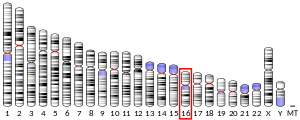^ a b c GRCh38: Ensembl release 89: ENSG00000213380 – Ensembl , May 2017^ a b c GRCm38: Ensembl release 89: ENSMUSG00000031916 – Ensembl , May 2017^ "Human PubMed Reference:" . National Center for Biotechnology Information, U.S. National Library of Medicine .^ "Mouse PubMed Reference:" . National Center for Biotechnology Information, U.S. National Library of Medicine .^ Ungar D, Oka T, Brittle EE, Vasile E, Lupashin VV, Chatterton JE, Heuser JE, Krieger M, Waters MG (Apr 2002). "Characterization of a mammalian Golgi-localized protein complex, COG, that is required for normal Golgi morphology and function" . J Cell Biol . 157 (3): 405– 15. doi :10.1083/jcb.200202016 . PMC 2173297 PMID 11980916 . ^ a b "Entrez Gene: COG8 component of oligomeric golgi complex 8" .
Maruyama K, Sugano S (1994). "Oligo-capping: a simple method to replace the cap structure of eukaryotic mRNAs with oligoribonucleotides". Gene . 138 (1– 2): 171– 4. doi :10.1016/0378-1119(94)90802-8 . PMID 8125298 . Suzuki Y, Yoshitomo-Nakagawa K, Maruyama K, et al. (1997). "Construction and characterization of a full length-enriched and a 5'-end-enriched cDNA library". Gene . 200 (1– 2): 149– 56. doi :10.1016/S0378-1119(97)00411-3 . PMID 9373149 . Pellizzoni L, Charroux B, Rappsilber J, et al. (2001). "A functional interaction between the survival motor neuron complex and RNA polymerase II" . J. Cell Biol . 152 (1): 75– 85. doi :10.1083/jcb.152.1.75 . PMC 2193649 PMID 11149922 . Venter JC, Adams MD, Myers EW, et al. (2001). "The sequence of the human genome" . Science . 291 (5507): 1304– 51. Bibcode :2001Sci...291.1304V . doi :10.1126/science.1058040 PMID 11181995 . Whyte JR, Munro S (2001). "The Sec34/35 Golgi transport complex is related to the exocyst, defining a family of complexes involved in multiple steps of membrane traffic" . Dev. Cell . 1 (4): 527– 37. doi :10.1016/S1534-5807(01)00063-6 PMID 11703943 . Loh E, Hong W (2002). "Sec34 is implicated in traffic from the endoplasmic reticulum to the Golgi and exists in a complex with GTC-90 and ldlBp" . J. Biol. Chem . 277 (24): 21955– 61. doi :10.1074/jbc.M202326200 PMID 11929878 . Strausberg RL, Feingold EA, Grouse LH, et al. (2003). "Generation and initial analysis of more than 15,000 full-length human and mouse cDNA sequences" . Proc. Natl. Acad. Sci. U.S.A . 99 (26): 16899– 903. Bibcode :2002PNAS...9916899M . doi :10.1073/pnas.242603899 PMC 139241 PMID 12477932 . Ota T, Suzuki Y, Nishikawa T, et al. (2004). "Complete sequencing and characterization of 21,243 full-length human cDNAs" . Nat. Genet . 36 (1): 40– 5. doi :10.1038/ng1285 PMID 14702039 . Loh E, Hong W (2004). "The binary interacting network of the conserved oligomeric Golgi tethering complex" . J. Biol. Chem . 279 (23): 24640– 8. doi :10.1074/jbc.M400662200 PMID 15047703 . Gerhard DS, Wagner L, Feingold EA, et al. (2004). "The status, quality, and expansion of the NIH full-length cDNA project: the Mammalian Gene Collection (MGC)" . Genome Res . 14 (10B): 2121– 7. doi :10.1101/gr.2596504 . PMC 528928 PMID 15489334 .




